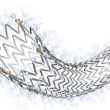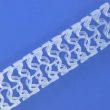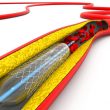This study evaluated the safety and efficacy of the new drug eluting stents (Medtronic, Santa Rosa, California) to treat de novo coronary lesions. These new polymer free drug filled stents have the potential to improve clinical outcomes and allow a shorter dual antiplatelet therapy. In addition, they have been made with three layers of continuous...
DES: Best Option in Saphenous Vein Grafts
These results confirm that, despite being used less and less worldwide, DES (drug eluting stents) are the best option in saphenous vein grafts. Saphenous vein graft atherosclerosis has a different pathophysiology to that of native arteries, and PCI in this context is less effective because of high risk of friable thromboembolic material, faster plaque...
Current Bare-Metal Stents: Similar to DES in the Very Long-Term
The largest randomized trial in history found no difference in the primary endpoint of death and nonfatal infarction between current conventional stents and drug-eluting stents at over 5 years in patients with stable or unstable coronary disease. As expected, NORSTENT did find a difference in revascularization rates between both groups. This study presented at the...
DES in primary PCI: The Best Option?
Courtesy of Dr. Brian Nazareth Donato. The relative safety of drug-eluting stents (DES) and conventional bare-metal stents (BMS) in primary angioplasty (percutaneous coronary intervention, PCI) in patients with ST elevation myocardial infarction (STEMI) is still subject of debate. A search was carried out using Medline, CENTRAL, EMBASE, TCTMD and Cardiosource. There were 9673 patients included,...
BVS: Comparable to Second-Generation DES in Complex Lesions
A center carrying out a mid- to long-term follow-up of the performance of everolimus-eluting bioresorbable scaffolds (Absorb) observed that this new device has an acceptable rate of major cardiovascular events, when compared to second-generation drug-eluting stents. Furthermore, although the population was complex and non-selected, no cases of early thrombosis were reported. This study enrolled 249 patients...
Tissue Protrusion after DES: Adverse Events at Long Term?
Original Title: Tissue Protrusion after Stent Implantation. An ADAPT-DES Intravascular Ultrasound Substudy. Reference: Fuyu Qiu et al. J Am Coll Cardiol Intv. 2016;9(14):1499-1507. After DES implantation we may observe tissue protrusion (plaque or thrombus) relatively often, especially in unstable lesions; however, its clinical impact has not been studied. The aim of this study was...
Stent thrombosis: Comparative analysis between BMS, DES and BRS
Original Title: Stent Thrombosis with Drug Eluting Stents and Bioresorbable Scaffolds. Evidence from a Network Meta-Analysis of 147 trials. Reference: Kang S et al. J Am Coll Cardiol Intv 2016 doi 10.1016. Courtesy of Dr. Guillermo Migliaro. When treating heart disease, drug eluting stents (DES) have become essential for PCI. Its main advantage lies on...
SYNTAX II: Initial outcomes of FFR/iFR and IVUS guided PCI with last generation DES in 3 vessel patients
Original Title: iFR/FFR and IVUS-guided percutaneous coronary revascularization with new-generation DES in patients with de novo three-vessel disease: 30-day outcomes of the SYNTAX II trial. Presenter: P. W. Serruys. The European Society of Cardiology guidelines recommend PCI for patients with multivessel disease and a Syntax score. A prospective, multicenter, single arm study was carried...
VELETI II: PCI to Intermediate coronary SVG lesions with DES
Original Title: Sealing intermediate non-obstructive coronary SVG lesions with DES as a new approach to maintaining vein graft patency and reducing cardiac events: the VELETI II randomized clinical trial. Presenter: J. Rodes Cabal. Non-obstructive SVG lesions affect mid-term prognosis negatively. There is little evidence on the safety and efficacy of non-obstructive intermediate SVG lesions...
Denervación simpática renal en pacientes con cardiodesfibrilador y tormenta eléctrica
Rodolfo Staico, Luciana Armaganijan, Dalmo A. R. Moreira, Paulo T. J. Medeiros, Jônatas Melo Neto, Dikran Armaganijan, Amanda G. M. R. Sousa, Alexandre Abizaid








